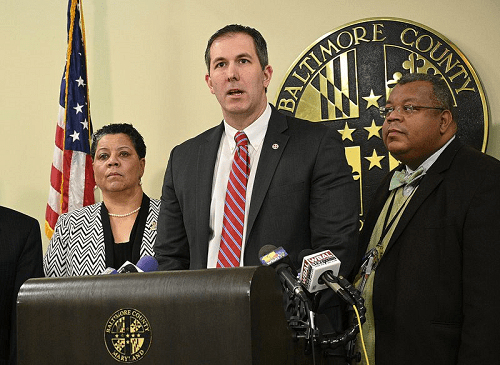
By WILBORN P. NOBLES III – BALTIMORE SUN |MAY 01, 2020 | 1:01 PM
A month ago, Baltimore County Executive Johnny Olszewski Jr. took the best budget projections available and submitted a spending proposal that anticipated revenues falling. It scaled back plans to hire new teachers, update county senior centers and build new athletic fields.
Now, those projections have — in the words of one council member — “collapsed” as government has shut down business activity to contain the coronavirus. The county is facing the possibility that revenues could fall by $270 million by the end of the next budget year, which could force officials to consider eliminating raises and extra school funding.
Baltimore County exemplifies the unprecedented fiscal challenge facing counties and cities as coronavirus has shut down the U.S. economy.
There could be “some pretty serious impacts” on operations such as public safety and other services because of the pandemic’s “significant disruption” to local economies, said Teryn Zmuda, chief economist for the National Association of Counties.Coronavirus in Maryland: Everything you need to know »
Maryland has been under a stay-at-home order for a month. The state is expecting a loss of $2.8 billion in revenue by June 30 due to business closures and other economic drivers. Already, local governments have initiated cost-saving efforts in anticipation of falling revenues.
Government hiring freezes are underway in Baltimore City and neighboring Baltimore, Anne Arundel, Howard, and Carroll counties. Baltimore City and Howard and Carroll counties have also limited nonessential purchases in an effort to limit expenses. The city and Carroll County postponed annual tax sales. And Harford County cut 25% of its anticipated parks and recreation projects, including plans for the Aberdeen Activity Center.Promote health. Save lives. Serve the vulnerable. Visit who.int
At the same time, local governments are spending millions of dollars in general funds and grants to provide emergency pay and protective equipment to employees in public safety, first-response services and food distribution.
Baltimore City and Baltimore County have both spent $20 million on COVID-related expenditures, and the city expects that figure to increase to $48 million by June. Howard has spent $4 million in COVID expenses, and Harford has spent $2.5 million.
“We’re feeling the impact on both sides, revenues and expenditures, and we’re not alone in facing a much more challenging outlook than we could have anticipated at the beginning of this year,” said Holly Sun, Howard County’s budget administrator. “We know this is going to stress our finances, but we are working to minimize severe actions and ensure our core services are supported.”
As he released his budget proposal Friday, Anne Arundel County Executive Steuart Pittman said revenue projections have declined by $63 million just since March 13. The Democrat said his $1.7 billion spending plan for fiscal 2021 doesn’t include merit or cost-of-living raises, except for union workers with contracts negotiated before the pandemic. The county will pay all employees a one-time supplement of $1,500, he said.
“A budget in uncertain times is a path. This budget is a difficult path. It required us to make some tough choices at the outset,” Pittman said.
He said the county is not able to fund new public safety positions, but will fill vacancies. He has frozen hiring for most other county offices, and the county’s public works and fire departments will see cuts in funding for heavy equipment purchases.
Baltimore City says employees could face pay cuts, furloughs and layoffs. Several members of the Baltimore County Council, Democrats and Republicans, say it’s better to consider cuts now rather than later.Maryland’s local governments brace for sharp decline in revenues as they fight coronavirus »
Local leaders say it’s unknown how hard the pandemic will hit government finances in the long run. But it’s bearing down on communities 12 years after the last test during the Great Recession.
To weather the last recession, cities were most likely to institute hiring freezes, layoffs, and delays or cancellations of infrastructure projects to balance budgets and cover shortfalls, according to National League of Cities data.
Cities tapped reserve funds to weather revenue declines from sales, property and income taxes. Some cities increased fees for services to raise money.
And the budget impacts of the last recession went on for several years. More than 40% of cities cut services, such as public works, libraries and parks and recreation programs in 2010 and 2011.
There were no significant local government job losses in Maryland during the recession, said Daraius Irani, an economist who is vice president of Towson University’s division of strategic partnerships and applied research. But, there was a hiring freeze that stopped “a long period of expansion for local government” statewide and in Baltimore’s metro area.
Some counties did enact furloughs or other pay reductions during the recession, said Michael Sanderson, executive director of the Maryland Association of Counties. Carroll County used layoffs, attrition and retirements to reduce its workforce by 12% in 2009, creating longer wait times for inspections and permits and reduced hours at community centers.
It’s unclear when the state might lift coronavirus-related restrictions, making local government budget forecasts more difficult.
Maryland Gov. Larry Hogan, a Republican, has outlined a three-stage plan to reopen businesses, but it would occur only after the state sees two weeks of decreased numbers of hospitalizations, use of intensive-care units and deaths due to the coronavirus. Maryland’s confirmed number of cases exceeds 20,000, and the state’s cumulative death toll from the pandemic is more than 1,000.
The most important thing local governments can do now is continue to consider their residents at risk of being hit hardest, such as the elderly, poor, African Americans and Latinos, said Christy McFarland, director of research for the National League of Cities.
Those communities will require assistance once moratoriums on water, power and other utility bills are lifted when the economy reopens, she said, “because it’s not going to reopen the same for everybody.”
Local governments have expressed hope Congress will approve more aid and that the federal government will reimburse them for pandemic expenses. But Baltimore County officials like Wade Kach, a Cockeysville Republican, say they shouldn’t delay tough budget decisions until then.
“I don’t think we can sit back and count on the federal government to bail us out,” Kach said.
Baltimore Sun reporter Alison Knezevich contributed to this article.Wilborn P. Nobles IIICONTACT
Wilborn covers Baltimore County for The Sun. Previously, he covered education for the Times-Picayune in New Orleans. The New Orleans native is a graduate of Louisiana State University and previously interned at the Washington Post.
